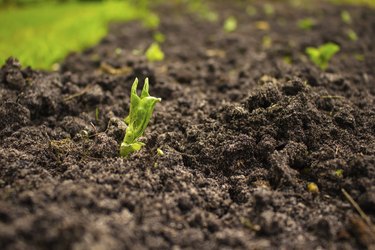
Trees, shrubs, perennial landscape plants and grass generally prefer acidic soil with a pH of 6 to 6.8. They usually do okay if the pH is between 5.5 and 7.5; however, when the pH falls below 5.5, many plants will not get the nutrients they need. Adding lime to the soil will raise the pH to more acceptable levels. Always test the soil first and use only the amount of lime needed based on the test results.
Soil pH, Health and Nutrients
Video of the Day
Soil with a pH below 5.5 becomes less healthy due to reduced microbial activity. Microbes break down organic matter and make the soil healthier for plants. They also break down grass clippings and reduce the layer of thatch in lawns. When the pH is 5.2 or lower, iron and manganese will actually interfere with a plant's ability to absorb magnesium, calcium, sulfur, potassium and, to a lesser extent, phosphorus and nitrogen. These are essential nutrients for all plants.
Video of the Day
Types of Lime
Calcitic lime, which is primarily calcium carbonate, and dolomitic lime, which is primarily magnesium, are made from pulverized limestone. They are mixed into the soil or broadcast over lawns to neutralize or raise the pH of acidic soil. When planning to landscape or put in a garden or lawn, begin liming the soil well in advance. It can take one to two years for lime to raise the soil pH to acceptable levels. Hydrated and burned lime raise the pH faster, but they should not be used. They cause serious burns on skin and plant foliage.
Determining Soil pH
Determine how acidic the soil is with a soil pH test. Kits and digital meters are readily available at garden centers. Take the soil sample from a depth of 2 inches for herbaceous perennials and grass and 4 inches for trees and shrubs. Soil pH is often slightly different just a few inches below the surface closer to plant roots. Test samples from multiple areas when a whole lawn or large garden area is being evaluated. Soil in different areas in the yard can have a different pH. The soil right next to a house with a concrete foundation or near a sidewalk or driveway can have a higher pH due to lime leaching into the soil.
Determining How Much to Use
Soil texture will determine how much lime is needed to raise the soil pH. Less is required for sandy soil than loamy or clay soil. Sandy soil is coarse and loose and falls apart easily even when moistened. Loam soil is a blend of sand and fine clay. It crumbles easily when moistened but not as easily as loose, sandy soil. Clay is heavy and sticks tightly together when moistened and squeezed in your hand.
To adjust the pH of 50 square feet of soil up by 1 unit, or from 5.5 to 6.5:
- Sandy soil requires 2.5 pounds of lime
- Loamy soil requires 4.25 pounds of lime
- Clay soil requires 5.5 pounds of lime
When applying lime on an established lawn, do not apply more than 25 pounds per 500 square feet at one time. If more than that is required, divide the total amount of lime needed into two applications spaced six months apart.
Applying Lime
Turn the soil with a rototiller to a depth of 1 foot. Spread the lime over the soil with a spinner-type spreader and mix it into the soil. Mix it in thoroughly with a rototiller. Lime does not dissolve quickly or move easily into the soil. Wear protective eyewear and clothing when applying lime.
It can be applied at any time of year but fall is preferable. Freezing, thawing, rain and snow will help distribute the lime in the soil. Spread the lime on a calm day so it doesn't blow away.
Test the soil again in 40 to 60 days or in the spring to see how much the pH has changed. If it has not changed dramatically, more lime can be added. However, it is better to wait until fall to test again and apply more lime, if necessary, since it can take one to two years to see the final results. If more lime is added too soon, the end result may be a pH that is too high.
When two applications are necessary for an established lawn, apply one in the fall and the other in the spring. Water the grass after spreading lime on the lawn to wash it off the blades and into the soil.
- University of Minnesota Extension: SULIS: Modifying Soil pH
- Colorado State University Extension: CMG Garden Notes: Soil pH
- University of Georgia Extension: Landscape Basics: Success with Herbaceous Perennials
- The Ohio State University Extension Fact Sheet: Understanding Soil Microbes and Nutrient Recycling
- Penn State: Center for Turfgrass Science: Liming Turfgrass Areas: What Is Soil pH?
- Penn State: Center for Turfgrass Science: Liming Turfgrass Areas: Why is Liming Important?
- University of Arkansas Cooperative Extension Service: Liming Your Lawn
- Penn State: Center for Turfgrass Science: Liming Turfgrass Areas: How Should Limestone Be Applied?